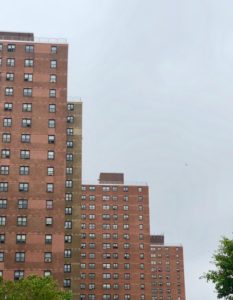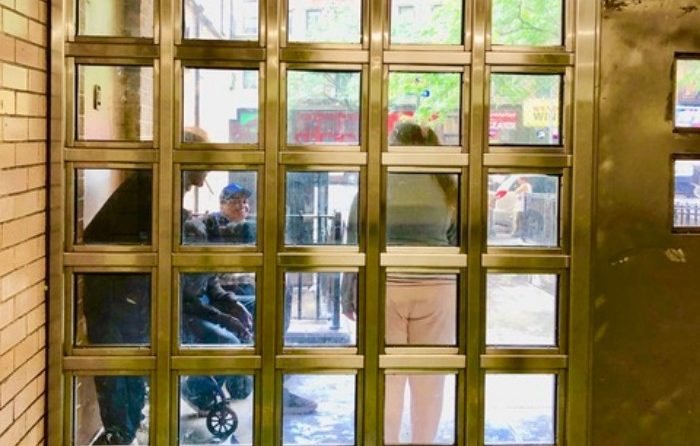The first thing that greets you when you walk in is the stench of Pampers and rotten food, rodents and cats feeding out of the garbage,” said Yordani,* a middle-aged man who lives in the Drew-Hamilton Houses in Harlem. “And two blocks down is a multi-million dollar apartment building. There are two different Americas, there are two different New York Cities.”
A healthy, safe and sanitary living environment is just a dream for far too many public housing tenants in New York City. Instead, their apartments are infested with rats and roaches, and contaminated with mold from leaky pipes and peeling lead paint. Mold exacerbates and causes respiratory problems. Over 800 children under the age of six have shown elevated levels of lead in their blood. Some have eaten lead paint and gotten sick.
Elevators and boilers break down regularly, light bulbs in halls and stairways aren’t replaced and trash doesn’t get picked up. Repairs? Forget about it—there is a backlog of more than 170,000 open work orders. When elevators aren’t repaired, residents who use wheelchairs and walkers and frail seniors are trapped in their apartments—sometimes for days. If the boiler is on the fritz, residents are left without heat.
Decades of defunding and disinvestment by the federal government are to blame for these deplorable and dangerous living conditions. But so is the New York City Housing Authority (NYCHA), which owns and manages 325 building developments that house over 400,000 people. Conditions are so bad that in 2018 federal prosecutors accused NYCHA of endangering residents’ lives; a civil complaint filed by the United States attorney in Manhattan forced NYCHA to submit to oversight by a court-appointed monitor.
So the background is dystopian. What may seem counterintuitive is that a total smoking ban—imposed on all public housing authorities by the US Department of Housing and Urban Development (HUD) in 2018—is making things worse.
NYCHA’s HUD-imposed Smoke-Free Policy:
“Prohibits the smoking of tobacco products inside public housing apartments; in all indoor common areas; and within twenty-five (25) feet of public housing buildings … Smoking in these areas is a violation of the public housing lease. Prohibited tobacco products are any item that involves the ignition and burning of tobacco leaves, including cigarettes, cigars, pipes, and water pipes (hookahs). In addition, using electronic cigarettes (also called e-cigarettes or e-cigs) in indoor common areas is prohibited under local law. Local law does not prohibit the use of electronic cigarettes outdoors or inside apartments.”
The policy is problematic, first because of the removal of civil liberties and agency for low-income people; and second because of harshly punitive, disproportionately targeted consequences—up to and including eviction—for people who smoke (or who vape in common areas).
The ban in NYCHA buildings and all HUD-funded housing goes too far by including smoking inside tenants’ apartments.
The justification for passing the smoking ban, of course, was to improve public health—in particular, by reducing vulnerable populations’ exposure to secondhand smoke. Creating a healthy, smoke-free living environment is clearly a good aim. Few would disagree that smoking should be banned in workplaces, bars, restaurants—or in common areas in housing developments—because of the dangers of secondhand smoke.
But the ban in NYCHA buildings and all HUD-funded housing goes further—too far—by including smoking inside tenants’ apartments.
The policy bans an activity that is legal—one that wealthier people in private housing are free to pursue. It allows NYCHA and other public housing authorities to police tenants’ behavior in the privacy of their own homes. Some tenants have rightly raised the concern that if NYCHA can prohibit and police smoking inside their apartments, it sets a worrying precedent.
The smoking ban prompted the organization Citizens Lobbying Against Smoking Harassment (CLASH) to file a lawsuit against HUD last year. “This lawsuit is about defending the right to be left alone to engage in a legal activity in the privacy of one’s own home,” stated Audrey Silk, the founder of CLASH. “HUD claims the ban is necessary to protect non-smoking residents in other apartments, but not only are they exceeding their authority, the lack of sound scientific evidence that someone smoking in their own apartment puts other tenants’ health at risk hasn’t stopped them either…”
“Are they going to ban alcohol next?” asked Drew-Hamilton Houses resident Yordani. “It all boils down to civil liberties. How much are we going to allow the system to control us and allow us to be monitored like you’re in prison?”

The Drew-Hamilton Houses in Harlem, New York City
Yordani, who has prostate cancer and lives with his terminally ill father who uses oxygen, supports the smoking ban, however.
“Even though they are infringing on people’s rights to smoke in their own home,” he explained, “I’ve had situations where my neighbors will smoke and the smell travels through the walls and the windows and it affects the quality of life for individuals that don’t smoke. Quality of life is important. Do you want to live in a place where smoking is affecting your children’s breathing, do you want to live in a building where there are cigarette butts and ashes in the breezeway? Do you want to live in a building where someone falls asleep with a lit cigarette and cause a fire? You have to weigh the advantages and disadvantages of smoking.”
Walls thin enough to be permeable to smells are a problem in themselves. But for tenants who smoke the ban has only added to their long list of concerns.
Historically disadvantaged groups such as people with physical disabilities and mental health or drug problems, people of color and people with low incomes are more likely to smoke and also more likely to live in public housing.
Claudia Perez, the president of the tenants association of Washington Houses in East Harlem, estimates that between 30 to 40 percent of tenants smoke.
The ban therefore targets and discriminates against the most vulnerable smokers—populations that also have low rates of quitting.
When I asked Yordani how he thought NYCHA would enforce the no-smoking policy, he had more questions than answers. “Are they going to have a monitor going in and out of the buildings or will there be cameras? Will there be a scientific way to prove that you are smoking in your apartment? How can you enforce the ban if you don’t physically see the person smoking?”
In fact, NYCHA does have an enforcement plan, at least on paper: a “graduated enforcement” approach. The policy states, “NYCHA will respond to violations with escalated warnings and specific, progressive enforcement remedies while also connecting residents to resources.”
And how will staff know the smoking ban has been violated? The policy explains:
“Residents may report violations by calling the Customer Contact Center or notifying the Property Management office and providing details of the violation a household member, guest, or other visitor who is observed smoking in a restricted area or evidence of use of a prohibited tobacco product in a restricted area. Some examples include: observing an ashtray containing used cigarettes, or smelling tobacco smoke emanating from an apartment.”
Enforcement therefore depends on residents turning in other residents. This has the potential to create tension among neighbors, as an avenue for score-settling and reprisals against tenants who report others.
Surprisingly in the age of ubiquitous cell phone cameras, NYCHA doesn’t mention photos or video being used as proof of smoking—but there is no doubt that such evidence will be used.
A single resident’s noncompliance with the smoke-free policy could result in eviction of all residents within that unit.
The most serious consequence of violating the smoke-free policy is eviction. During initial discussions about the policy, tenants’ organizations asked HUD to take eviction off the table. HUD refused.
In fact, HUD’s final rule even gave public housing authorities the right to evict residents who permit guests to smoke in their homes. What’s more, a single resident’s noncompliance with the smoke-free policy could result in eviction of all residents within that unit.
This policy of collective punishment has previously been applied to tenants’ use of illegal drugs in public housing, with disastrous consequences. NYCHA tenants, who are disproportionately black and Latinx, have seen their civil rights eroded for decades because of racist over-policing by NYPD practices like stop-and-frisk and Operation Clean Halls.
How does evicting individuals or families for violating the smoking ban advance public health goals, given most of the people evicted will end up on the street or in a shelter? People who are homeless not only have high rates of smoking; they’re also are at a much greater risk of acquiring an array of health problems.
Smoking off-site just isn’t an option for every smoker in public housing, given the structural barriers in many NYCHA buildings. Smokers who use wheelchairs or other assistive devices, or are elderly and frail, often don’t have elevators that work everyday. Poor or absent lighting in halls and stairwells makes them dangerous to use. And smoking outside is a non-starter for people who have chronic diseases and are bed- or house-bound.
What are tenants who smoke—and miraculous instant quitting is never going to happen in most cases—supposed to do if they can’t physically exit their building?
The only approved smoking zones are outside a 25-foot perimeter. Yordani had some common-sense suggestions. “They need to have a backup plan for people who can’t get out. They could open the windows in the breezeway or put in filtration systems. But it’s not going to happen if you can’t even get a bathroom fixed. They’re not going to spend money on that.”
The ban also doesn’t take inclement weather or extreme climates into account. There are no designated indoor areas for smokers in the case of rain, snow, freezing temperatures, or heat waves—when people are often told by NYC public health officials to stay indoors to avoid heat stroke.
Some public housing developments are located in high-crime areas, so safety is another issue for smokers, particularly at night. This safety threat impacts everyone, but certain groups are particularly vulnerable, such as people with disabilities and women.
The HUD smoking ban targets vulnerable groups that have the highest rates of smoking and the most difficulty quitting. The ban should be opposed because it’s inhumane—a set-up for evictions which will lead to homelessness for those least equipped to cope.
Rather than prohibition and punishment, a full range of tobacco harm reduction options and ongoing support should be widely offered and free to empower public housing residents who smoke to improve their own health.
*Name has been changed to protect privacy.
Photographs by Helen Redmond





Show Comments